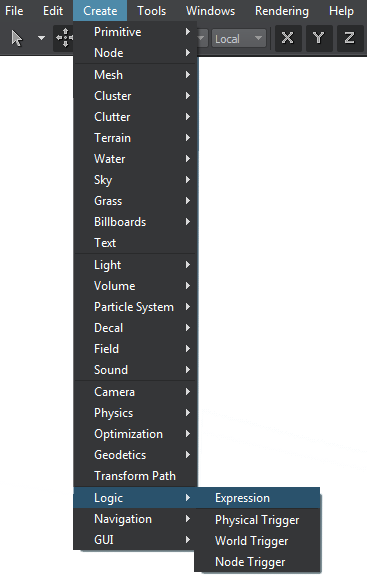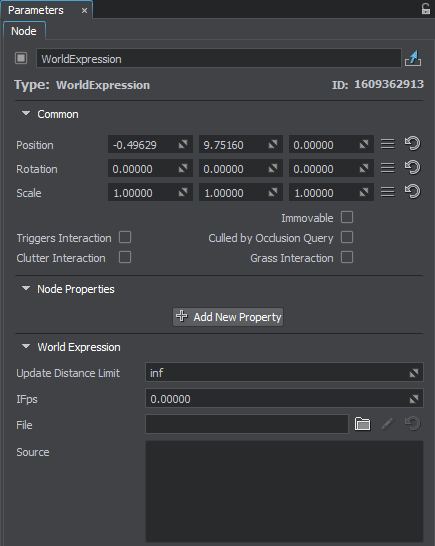World Expression
A world expression is a point object, which executes arbitrary expressions (scripts) at the specified distance and frame rate. By default, expressions are executed at the same frame rate as the main application.
By using world expressions, you can attach a script to an object in the scene. To do that, such object must be added as a child node to the world expression. Child nodes inherit transformations (if any) of the world expression.
For example, by using the world expression, you can transform objects in the scene, turn on and off sounds with the distance, turn on and off NPC behavior, attach objects to the camera (e.g. drops of the rain on the camera), and so on.

See also#
- The WorldExpression class to manage world expressions via API
- A tutorial on Adding Scripts to the Project
- A set of samples located in the <UnigineSDK>/data/samples/worlds/ folder:
- expression_00 — expression_05
Creating World Expression#
To create a world expression via UnigineEditor:
- In the Menu bar, click Create -> Logic -> Expression.

- Place the world expression somewhere in the world.
Attaching World Expression Script#
There are two ways of attaching a world expression script via UnigineEditor:
- Directly in UnigineEditor in the Parameters window -> Node tab -> World Expression section -> Source field. The source code must be inside the curly braces {} as they define the world expression scope.

- Attached as a script file in the Parameters window -> Node tab -> World Expression section -> File field. The script file should be included in the world expression scope in the Source field. The curly braces {} are also required:
In this case, the my_expression.h should contain the following code: Source code (UnigineScript)
Source code (UnigineScript)log.message("WorldExpression is updated\n");NoticeIn the script file, the source code must not be wrapped with curly braces {}.
Implementing Script#
The script itself can be implemented as a simple sequence of functions' calls or as a set of functions and classes. See examples here.
Inter-Script Communication#
Such script can communicate with the world script via the corresponding engine.world functions or with world triggers via callbacks (see the samples listed above).
Script Functions#
Besides functions of the UnigineScript library, there is also a set of internal functions that are available within the world expression script. The list of such functions with descriptions and examples can be found here.
Setting World Expression Parameters#
You can adjust the following parameters of the world expression in the Node tab:

| Update Distance Limit | Range of the distance from the camera, within which the expression is executed. |
|---|---|
| IFps | A constant frame duration (inverse FPS, 1/FPS) used to execute the expression. If 0 is set, the expression is executed at the same frame rate as the main application. |
| File | A path to a file with a world expression script to be executed. The path is relative to the data directory. This file should be included in the world expression scope in the Source field. This field is optional as the world expression script can be implemented directly via the UnigineEditor interface (see the description of the Source field below).
Notice
If the script file is changed, it should be refreshed via UnigineEditor: click
 to the right of the
File field. to the right of the
File field. |
| Source | Source code of a world expression script. This field can contain:
Notice
In both cases, the curly braces {} must wrap the code in the field. |
Deleting World Expression#
To delete the world expression via UnigineEditor, right-click the world expression node in the nodes hierarchy list and press Delete.